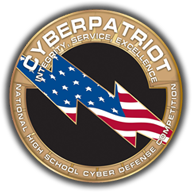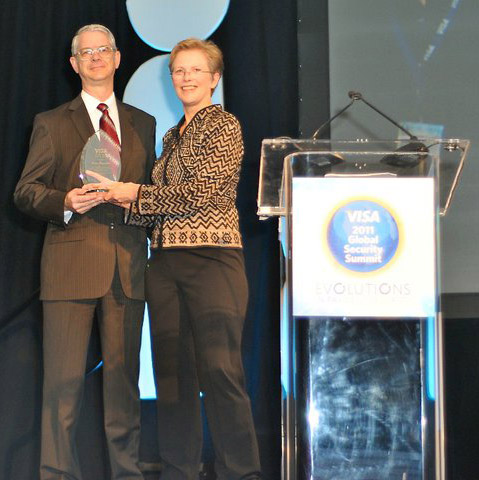Past Winners
2023
![]() Stanford University
Stanford University ![]() California Polytechnic State University, Pomona
California Polytechnic State University, Pomona ![]() DePaul University
DePaul University
Other Finalists: University of North Florida, Dakota State University, Northeastern University, University of Texas, Brigham Young University, Oregon State University, University of Virginia
2022
![]() University of Central Florida
University of Central Florida ![]() Dakota State University
Dakota State University ![]() Stanford University
Stanford University
Other Finalists: Oregon State University, University of Texas, Brigham Young University, Northeastern University, DePaul University, Liberty University, University of Virginia
2021
![]() University of Central Florida
University of Central Florida ![]() DePaul University
DePaul University ![]() George Mason
George Mason
Other Finalists: Rochester Institute of Technology, University of Texas, Brigham Young University, University of Washington, University of Maryland Baltimore County, College of Charleston, University of California Irvine
2020
![]() University of Virginia
University of Virginia ![]() University of Central Florida
University of Central Florida ![]() Stanford University
Stanford University
Other Finalists: Rochester Institute of Technology, University of Tulsa, Red Rocks Community College, DePaul University, University of Washington, University of Maryland Baltimore County, Kennesaw State University
2019
![]() University of Virginia
University of Virginia ![]() University of Central Florida
University of Central Florida ![]() Rochester Institute of Technology
Rochester Institute of Technology
Other Finalists: University of Tulsa, Utah Valley University, Dakota State University, University of Washington, Stanford University, University of Alaska Anchorage, Baldwin Wallace University
2018
![]() University of Virginia
University of Virginia ![]() University of Central Florida
University of Central Florida ![]() Dakota State University
Dakota State University
Other Finalists: Baylor University, Utah Valley University, Indiana Tech, University of Washington, California State University Northridge, University of Alaska Fairbanks, University at Buffalo
2017
![]() University of Maryland Baltimore County
University of Maryland Baltimore County ![]() University of Tulsa
University of Tulsa ![]() Brigham Young University
Brigham Young University
Other Finalists: California State University Northridge, University of Washington, Montana Tech, University of South Alabama, Rochester Institute of Technology, University of Alaska Fairbanks, DePaul University
2016
![]() University of Central Florida
University of Central Florida ![]() Brigham Young University
Brigham Young University ![]() DePaul University
DePaul University
Other Finalists: Cal Poly Pomona, Columbia Basin College, Dakota State University, Liberty University, Northeastern University, University of Alaska Anchorage, University of Tulsa
2015
![]() University of Central Florida
University of Central Florida ![]() University of California at Berkeley
University of California at Berkeley ![]() Rochester Institute of Technology
Rochester Institute of Technology
Other Finalists: DePaul University, ITT Technical Institute, Southern Utah University, University of Alaska Fairbanks, University of Maryland Baltimore County, University of Nebraska Kearney, University of Texas at San Antonio
2014
![]() University of Central Florida
University of Central Florida ![]() Rochester Institute of Technology
Rochester Institute of Technology ![]() University of Alaska at Fairbanks
University of Alaska at Fairbanks
Other Finalists: Air Force Academy, Dakota State University, Northern Kentucky University, Southern Methodist University, Towson University, University of California at Berkeley, Western Washington University
2013
![]() Rochester Institute of Technology
Rochester Institute of Technology ![]() Dakota State University
Dakota State University ![]() Rose-Hulman Institute of Technology
Rose-Hulman Institute of Technology
Other Finalists: Air Force Academy, Cal Poly Pomona, Millersville University, Oklahoma State University, University of Alaska at Fairbanks, University of Central Florida, University of Washington
2012
![]() University of Washington
University of Washington ![]() Air Force Academy
Air Force Academy ![]() Texas A&M University
Texas A&M University
Other Finalists: Cal Poly Pomona, Rochester Institute of Technology, St. Cloud State University, Towson University, University of Alaska at Fairbanks, University of North Carolina at Charlotte, University of Wyoming
2011
![]() University of Washington
University of Washington ![]() Texas A&M University
Texas A&M University ![]() University of Louisville
University of Louisville
Other Finalists: Air Force Academy, Cal Poly Pomona, Indiana Tech, Rochester Institute of Technology, University of Maryland, University of Wyoming
2010
![]() Northeastern University
Northeastern University ![]() University of Louisville
University of Louisville ![]() Cal Poly Pomona
Cal Poly Pomona
Other Finalists: DePaul University, Montana Tech, Texas A&M University, Towson University, University of Washington
2009
![]() Baker College at Flint
Baker College at Flint ![]() Northeastern University
Northeastern University ![]() Texas A&M University
Texas A&M University
Other Finalists: Cal Poly Pomona, Dakota State University, University of North Carolina at Charlotte, University of Pittsburgh, University of Washington
2008
![]() Baker College at Flint
Baker College at Flint ![]() Texas A&M University
Texas A&M University ![]() University of Louisville
University of Louisville
Other Finalists: Community College of Baltimore County, Mt. San Antonio College, Rochester Institute of Technology
2007
![]() Texas A&M University
Texas A&M University ![]() Millervsille University
Millervsille University ![]() University of Louisville
University of Louisville
Other Finalists: Indiana Tech
2006
![]() University of North Carolina at Charlotte
University of North Carolina at Charlotte ![]() Southern Illinois University
Southern Illinois University ![]() Millersville University
Millersville University
Other Finalists: University of Texas at San Antonio
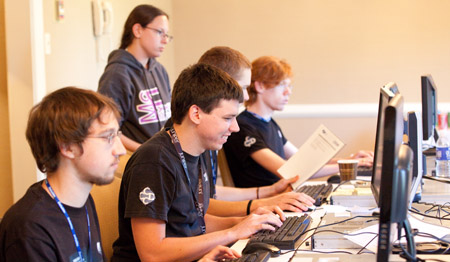 The mission of the Collegiate Cyber Defense Competition (CCDC) system is to provide institutions with an information assurance or computer security curriculum a controlled, competitive environment to assess their student's depth
The mission of the Collegiate Cyber Defense Competition (CCDC) system is to provide institutions with an information assurance or computer security curriculum a controlled, competitive environment to assess their student's depth 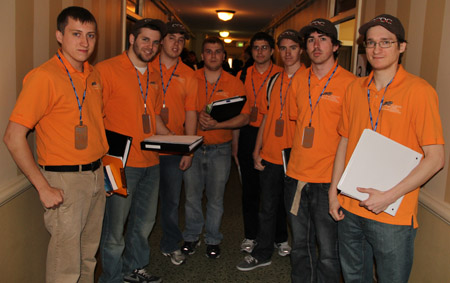 CCDC competitions ask student teams to assume administrative and protective duties for an existing “commercial” network – typically a small company with 50+ users, 7 to 10 servers, and common Internet services such as a web server, mail server, and e-commerce site. Each team begins the competition with an identical set of hardware and software and is scored on their ability to detect and respond to outside threats, maintain availability of existing services such as mail servers and web servers, respond to business requests such as the addition or removal of additional services, and balance security needs against business needs. Throughout the competition an automated scoring engine is used to verify the functionality and availability of each team’s services on a periodic basis and traffic generators continuously feed simulated user traffic into the competition network. A volunteer red team provides the “external threat” all Internet-based services face and allows the teams to match their defensive skills against live opponents.
CCDC competitions ask student teams to assume administrative and protective duties for an existing “commercial” network – typically a small company with 50+ users, 7 to 10 servers, and common Internet services such as a web server, mail server, and e-commerce site. Each team begins the competition with an identical set of hardware and software and is scored on their ability to detect and respond to outside threats, maintain availability of existing services such as mail servers and web servers, respond to business requests such as the addition or removal of additional services, and balance security needs against business needs. Throughout the competition an automated scoring engine is used to verify the functionality and availability of each team’s services on a periodic basis and traffic generators continuously feed simulated user traffic into the competition network. A volunteer red team provides the “external threat” all Internet-based services face and allows the teams to match their defensive skills against live opponents.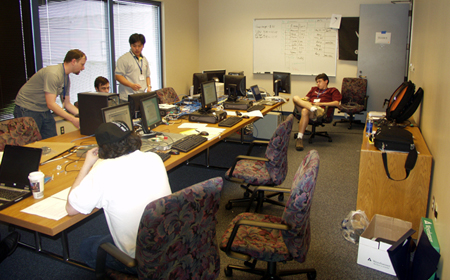 On February 27 and 28, 2004, a group of educators, students, government and industry representatives gathered in San Antonio, Texas, to discuss the feasibility and desirability of establishing regular cyber security exercises with a uniform structure for post-secondary level students. During their discussions this group suggested the goals of creating a uniform structure for cyber security exercises might include the following:
On February 27 and 28, 2004, a group of educators, students, government and industry representatives gathered in San Antonio, Texas, to discuss the feasibility and desirability of establishing regular cyber security exercises with a uniform structure for post-secondary level students. During their discussions this group suggested the goals of creating a uniform structure for cyber security exercises might include the following: an effort to help facilitate the development of a regular, national level cyber security exercise, the Center for Infrastructure Assurance and Security at the University of Texas at San Antonio agreed to host the first Collegiate Cyber Defense Competition (CCDC) for the Southwestern region in April of 2005. While similar to other cyber defense competitions in many aspects, the CCDC is unique in that it focuses on the operational aspect of managing and protecting an existing network infrastructure. While other exercises examine the abilities of a group of students to design, configure, and protect a network over the course of an entire semester, this competition is focused on the more operational task of assuming administrative and protective duties for an existing “commercial” network. Teams are scored based on their ability to detect and respond to outside threats, maintain availability of existing services such as mail servers and web servers, respond to business requests such as the addition or removal of additional services, and balance security needs against business needs.
an effort to help facilitate the development of a regular, national level cyber security exercise, the Center for Infrastructure Assurance and Security at the University of Texas at San Antonio agreed to host the first Collegiate Cyber Defense Competition (CCDC) for the Southwestern region in April of 2005. While similar to other cyber defense competitions in many aspects, the CCDC is unique in that it focuses on the operational aspect of managing and protecting an existing network infrastructure. While other exercises examine the abilities of a group of students to design, configure, and protect a network over the course of an entire semester, this competition is focused on the more operational task of assuming administrative and protective duties for an existing “commercial” network. Teams are scored based on their ability to detect and respond to outside threats, maintain availability of existing services such as mail servers and web servers, respond to business requests such as the addition or removal of additional services, and balance security needs against business needs.
